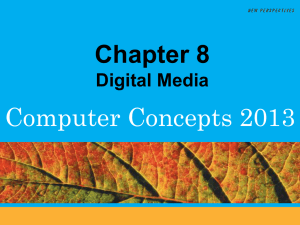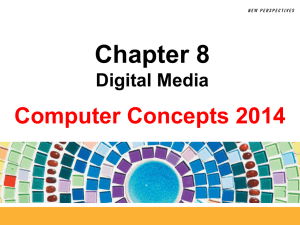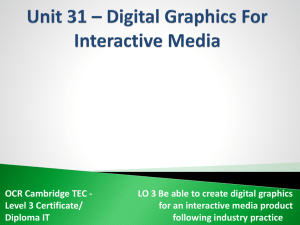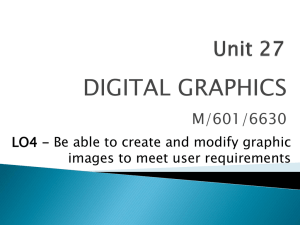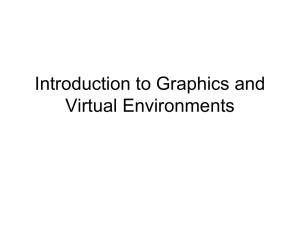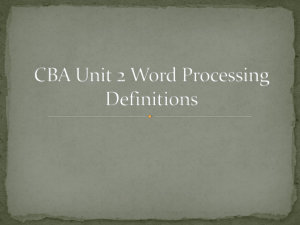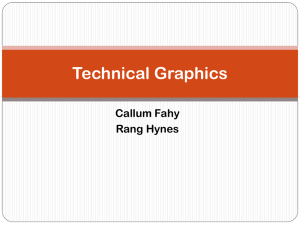NP10_Chapter08
advertisement
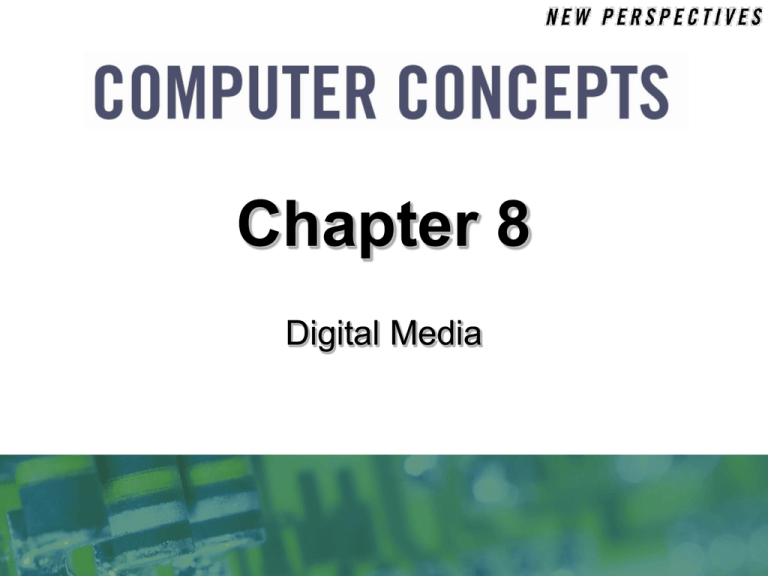
Chapter 8 Digital Media 8 Chapter Contents Section A: Digital Sound Section B: Bitmap Graphics Section C: Vector and 3-D Graphics Section D: Digital Video Section E: Digital Rights Management Chapter 8: Digital Media 2 8 SECTION A Digital Sound Digital Audio Basics Portable Audio Players MIDI Music Speech Recognition and Synthesis Chapter 8: Digital Media 3 8 Digital Audio Basics Digital representation of sound Chapter 8: Digital Media 4 8 Digital Audio Basics Sampling rate refers to number of times per second that a sound is measured Chapter 8: Digital Media 5 8 Digital Audio Basics Sound cards are responsible for transforming bits stored in an audio file into music, sound effects, and narrations – Digital Signal Processor (DSP) Chapter 8: Digital Media 6 8 Waveform Audio The most popular waveform audio formats (a.k.a., digital audio) include AAC, AIFF, MP3, RealAudio, Wave, and WMA Audio or media player software allows you to record and play waveform audio files You can embed waveform files into a Web page and/or other types of documents Chapter 8: Digital Media 7 8 MIDI Music (Synthesized Sound) MIDI (Musical Instrument Digital Interface) specifies a standard way to store music data for synthesizers, electronic MIDI instruments, and computers MIDI-capable sound cards contain a wavetable – Set of prerecorded musical instrument sounds Does not produce high-quality vocals Does not have full resonance of “real” sound Chapter 8: Digital Media 9 8 MIDI Music Music composition software provides tools for entering notes, specifying instruments, printing sheet music, and saving compositions in formats such as MIDI. Chapter 8: Digital Media 11 8 Speech Recognition and Synthesis Speech synthesis is the process by which machines produce sound resembling spoken words – Text-to-speech software Speech recognition refers to the ability of a machine to understand spoken words – Speech recognition software Chapter 8: Digital Media 12 8 SECTION B Bitmap Graphics Bitmap Basics Scanners and Cameras Image Resolution Color Depth and Palettes Image Compression Bitmap Graphics Formats Chapter 8: Digital Media 14 8 Bitmap Graphics Viewed as a grid of dots – Color and intensity of each dot is stored as a binary number (commonly 24 bits) Chapter 8: Digital Media 15 8 Scanners and Cameras Graphics software is used to modify or edit bitmap graphics – Modify individual pixels (dots) to • Retouch photographs • Wipe out red eye • Erase rabbit ears Often require quite a lot of storage and memory space Chapter 8: Digital Media 19 8 Image Resolution Expressed as the number of horizontal and vertical pixels – Higher resolutions contain more data (larger file size) and are higher quality Bitmaps do not have a fixed physical size Chapter 8: Digital Media 20 8 Image Resolution When you increase the resolution of a bitmap, pixel interpolation may occur – Some images may appear pixelated (grainy) Chapter 8: Digital Media 22 8 Color Depth and Palettes Color depth is the number of colors available for use in an image – Monochrome bitmap Increasing color depth increases file size – True Color bitmap (24-bit bitmap) – 32-bit bitmap Color palettes are used to control color depth – Grayscale palette – System palette – Web palette Chapter 8: Digital Media 23 8 Color Depth and Palettes Chapter 8: Digital Media 24 8 Image Compression Any technique that recodes data in an image file so it contains fewer bits – Lossless compression – Lossy compression File compression utility Chapter 8: Digital Media 25 8 Bitmap Graphic Formats Chapter 8: Digital Media 27 8 SECTION C Vector and 3-D Graphics Vector Graphics Basics Vector-to-Bitmap Conversion Vector Graphics on the Web 3-D Graphics Chapter 8: Digital Media 28 8 Vector Graphic Basics Contain instructions for re-creating a picture Chapter 8: Digital Media 29 8 Vector Graphic Basics Vector graphics resize better than bitmaps Vector graphics usually require less storage space than bitmaps Vector graphics are not usually as realistic as bitmap images It is easier to edit an object in a vector graphic than an object in a bitmap graphic Chapter 8: Digital Media 30 8 Vector Graphic Basics Chapter 8: Digital Media 31 8 Vector-to-Bitmap Conversion Rasterization superimposes a grid over a vector image and determines the color for each pixel Tracing software locates the edges of objects in a bitmap image and converts the resulting shapes into vector graphic objects Chapter 8: Digital Media 32 8 3-D Graphics Stored as a set of instructions – Contain locations and lengths of lines forming a wireframe Rendering covers a wireframe with surface color and texture Ray tracing adds light and shadows to a 3-D image Chapter 8: Digital Media 34 8 3-D Graphics 3-D graphics software provides tools for drawing a wireframe and then specifying colors and textures for rendering. Chapter 8: Digital Media 35 8 SECTION D Digital Video Digital Video Basics Producing Video Footage Video Transfer Video Editing Video Output Desktop, PDA, and Web Video DVD-Video Chapter 8: Digital Media 36 8 Digital Video Basics Uses bits to store color and brightness data for each video frame Different kinds of digital videos: – Desktop video – Web-based video – DVD-video – PDA video Chapter 8: Digital Media 37 8 Digital Video Basics Consider the same issues as with still video: – Resolution of each frame – Color depth of each frame Added issue to consider is number of frames per second that are captured – More frames, smoother video – More frames, more storage required (compression?) Chapter 8: Digital Media 38 8 Video Output Chapter 8: Digital Media 46 8 Video Output Chapter 8: Digital Media 47 Chapter 8 Complete Digital Media
